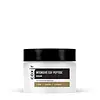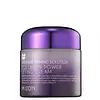What's inside
What's inside
 Key Ingredients
Key Ingredients

 Benefits
Benefits

 Concerns
Concerns

No concerns
 Ingredients Side-by-side
Ingredients Side-by-side

Water
Skin ConditioningGlycerin
HumectantGlyceryl Acrylate/Acrylic Acid Copolymer
HumectantPropylene Glycol
HumectantButylene Glycol Dicaprylate/Dicaprate
EmollientDimethicone/Vinyl Dimethicone Crosspolymer
Skin ConditioningMethyl Gluceth-20
HumectantNiacinamide
Smoothing1,2-Hexanediol
Skin ConditioningBetaine
HumectantDiisostearyl Malate
EmollientCyclomethicone
EmollientPEG/PPG-18/4 Copolymer
SolventSodium Acrylate/Sodium Acryloyldimethyl Taurate Copolymer
Emulsion StabilisingIsohexadecane
EmollientPolysorbate 80
EmulsifyingAdenosine
Skin ConditioningButylene Glycol
HumectantHydrogenated Lecithin
EmulsifyingSh-Oligopeptide-1
Skin ConditioningCopper Tripeptide-1
Skin ConditioningHydrogenated Vegetable Oil
EmollientTri-C14-15 Alkyl Citrate
EmollientMyrciaria Dubia Fruit Extract
Skin ConditioningMalpighia Emarginata Fruit Extract
Skin ConditioningTocopheryl Acetate
AntioxidantArginine
MaskingCarbomer
Emulsion StabilisingPanthenol
Skin ConditioningLonicera Japonica Flower Extract
Skin ConditioningSolanum Lycopersicum Fruit Extract
AntioxidantLilium Tigrinum Extract
Skin ConditioningNelumbo Nucifera Seed Extract
AntimicrobialChrysanthemum Indicum Flower Extract
Skin ConditioningHydrolyzed Collagen
EmollientAcanthopanax Senticosus Root Extract
Skin ConditioningPunica Granatum Fruit Extract
AntioxidantPanax Ginseng Root Extract
EmollientCarthamus Tinctorius Flower Extract
Skin ConditioningXanthan Gum
EmulsifyingMalva Sylvestris Flower Extract
Skin ConditioningBuddleja Davidii Extract
Skin ConditioningThymus Vulgaris Extract
PerfumingCamellia Sinensis Callus Culture Extract
PerfumingPhaseolus Radiatus Meristem Cell Culture Extract
Skin ConditioningPanax Ginseng Callus Culture Extract
Skin ConditioningPhenoxyethanol
PreservativeEthylhexylglycerin
Skin ConditioningParfum
MaskingWater, Glycerin, Glyceryl Acrylate/Acrylic Acid Copolymer, Propylene Glycol, Butylene Glycol Dicaprylate/Dicaprate, Dimethicone/Vinyl Dimethicone Crosspolymer, Methyl Gluceth-20, Niacinamide, 1,2-Hexanediol, Betaine, Diisostearyl Malate, Cyclomethicone, PEG/PPG-18/4 Copolymer, Sodium Acrylate/Sodium Acryloyldimethyl Taurate Copolymer, Isohexadecane, Polysorbate 80, Adenosine, Butylene Glycol, Hydrogenated Lecithin, Sh-Oligopeptide-1, Copper Tripeptide-1, Hydrogenated Vegetable Oil, Tri-C14-15 Alkyl Citrate, Myrciaria Dubia Fruit Extract, Malpighia Emarginata Fruit Extract, Tocopheryl Acetate, Arginine, Carbomer, Panthenol, Lonicera Japonica Flower Extract, Solanum Lycopersicum Fruit Extract, Lilium Tigrinum Extract, Nelumbo Nucifera Seed Extract, Chrysanthemum Indicum Flower Extract, Hydrolyzed Collagen, Acanthopanax Senticosus Root Extract, Punica Granatum Fruit Extract, Panax Ginseng Root Extract, Carthamus Tinctorius Flower Extract, Xanthan Gum, Malva Sylvestris Flower Extract, Buddleja Davidii Extract, Thymus Vulgaris Extract, Camellia Sinensis Callus Culture Extract, Phaseolus Radiatus Meristem Cell Culture Extract, Panax Ginseng Callus Culture Extract, Phenoxyethanol, Ethylhexylglycerin, Parfum
Water
Skin ConditioningHydrolyzed Collagen
EmollientHouttuynia Cordata Extract
Skin ConditioningTrehalose
HumectantSorbitan Isostearate
EmulsifyingRoyal Jelly
Dextrin
AbsorbentCopper Tripeptide-1
Skin ConditioningPolyisobutene
Theobroma Cacao Extract
Skin ConditioningBHT
AntioxidantGlycerin
HumectantBeta-Glucan
Skin ConditioningPolyacrylate-13
Polysorbate 20
EmulsifyingPhenoxyethanol
PreservativeCetearyl Dimethicone Crosspolymer
Cyclopentasiloxane
EmollientPropanediol
SolventIris Florentina Root Extract
MaskingDimethicone
EmollientAdenosine
Skin ConditioningCoptis Chinensis Root Extract
AntioxidantSalvia Hispanica Seed Extract
EmollientEthylhexylglycerin
Skin ConditioningXanthan Gum
EmulsifyingBis-PEG-18 Methyl Ether Dimethyl Silane
EmollientCentella Asiatica Extract
CleansingPrunus Amygdalus Dulcis Seed Extract
Skin ConditioningPropolis Extract
Skin ConditioningCarbomer
Emulsion StabilisingButylene Glycol
HumectantHydrolyzed Royal Jelly Protein
Skin Conditioning1,2-Hexanediol
Skin ConditioningCyclohexasiloxane
EmollientDisodium EDTA
Sodium Hyaluronate
HumectantTromethamine
BufferingWater, Hydrolyzed Collagen, Houttuynia Cordata Extract, Trehalose, Sorbitan Isostearate, Royal Jelly, Dextrin, Copper Tripeptide-1, Polyisobutene, Theobroma Cacao Extract, BHT, Glycerin, Beta-Glucan, Polyacrylate-13, Polysorbate 20, Phenoxyethanol, Cetearyl Dimethicone Crosspolymer, Cyclopentasiloxane, Propanediol, Iris Florentina Root Extract, Dimethicone, Adenosine, Coptis Chinensis Root Extract, Salvia Hispanica Seed Extract, Ethylhexylglycerin, Xanthan Gum, Bis-PEG-18 Methyl Ether Dimethyl Silane, Centella Asiatica Extract, Prunus Amygdalus Dulcis Seed Extract, Propolis Extract, Carbomer, Butylene Glycol, Hydrolyzed Royal Jelly Protein, 1,2-Hexanediol, Cyclohexasiloxane, Disodium EDTA, Sodium Hyaluronate, Tromethamine
Ingredients Explained
These ingredients are found in both products.
Ingredients higher up in an ingredient list are typically present in a larger amount.
1,2-Hexanediol is a synthetic liquid and another multi-functional powerhouse.
It is a:
- Humectant, drawing moisture into the skin
- Emollient, helping to soften skin
- Solvent, dispersing and stabilizing formulas
- Preservative booster, enhancing the antimicrobial activity of other preservatives
Adenosine is in every living organism. It is one of four components in nucleic acids that helps store our DNA.
Adenosine has many benefits when used. These benefits include hydrating the skin, smoothing skin, and reducing wrinkles. Once applied, adenosine increases collagen production. It also helps with improving firmness and tissue repair.
Studies have found adenosine may also help with wound healing.
In skincare products, Adenosine is usually derived from yeast.
Learn more about AdenosineButylene Glycol (or BG) is used within cosmetic products for a few different reasons:
Overall, Butylene Glycol is a safe and well-rounded ingredient that works well with other ingredients.
Though this ingredient works well with most skin types, some people with sensitive skin may experience a reaction such as allergic rashes, closed comedones, or itchiness.
Learn more about Butylene GlycolCarbomer is a polymer of acrylic acid. Its main role is to create a gel consistency.
A high amount of carbomer can cause pilling or balling up of products. Don't worry, most products contain 1% or less of carbomer.
Copper Tripeptide-1 (GHK-Cu) is a skin repairing ingredient known for its ability to boost collagen, improve firmness, and support skin regeneration.
It is a complex made up of a naturally occurring peptide (glycine-histidine-lysine) and copper, an essential trace element.
While studying wound healing, researchers noticed GHK-Cu stimulated hair follicle enlargement and growth by keeping hair in its active growth phase longer. This has made it a promising ingredient for hair regrowth treatments.
Some people have reported increased facial hair. While GHK-Cu can make your hair follicles bigger, it usually doesn’t turn soft, barely-visible facial hairs into thick, dark ones.
Anecdotal reports suggest that overusing copper peptides might lead to premature aging due to excess free copper or enzyme imbalances. This claim isn’t backed by large-scale studies.
Unfortunately, there are limited human studies for this ingredient. While early results are promising, many studies are either small, in-vitro, or not rigorously controlled.
For example, there is a 1998 study that explored the effects of copper tripeptide, vitamin C, tretinoin, and melatonin on skin repair and collagen synthesis.
After one month, increased procollagen production was seen in 7 out of 10 participants using copper tripeptide (more than those using vitamin C, melatonin, or tretinoin.
While the study was exploratory, it offers early evidence that copper tripeptide may support collagen production. Larger, well-designed trials are still needed to confirm its potential and understand individual responses.
Read more about other common types of peptides here:
Learn more about Copper Tripeptide-1Ethylhexylglycerin (we can't pronounce this either) is commonly used as a preservative and skin softener. It is derived from glyceryl.
You might see Ethylhexylglycerin often paired with other preservatives such as phenoxyethanol. Ethylhexylglycerin has been found to increase the effectiveness of these other preservatives.
Glycerin is already naturally found in your skin. It helps moisturize and protect your skin.
A study from 2016 found glycerin to be more effective as a humectant than AHAs and hyaluronic acid.
As a humectant, it helps the skin stay hydrated by pulling moisture to your skin. The low molecular weight of glycerin allows it to pull moisture into the deeper layers of your skin.
Hydrated skin improves your skin barrier; Your skin barrier helps protect against irritants and bacteria.
Glycerin has also been found to have antimicrobial and antiviral properties. Due to these properties, glycerin is often used in wound and burn treatments.
In cosmetics, glycerin is usually derived from plants such as soybean or palm. However, it can also be sourced from animals, such as tallow or animal fat.
This ingredient is organic, colorless, odorless, and non-toxic.
Glycerin is the name for this ingredient in American English. British English uses Glycerol/Glycerine.
Learn more about GlycerinHydrolyzed collagen has a misleading name because it is actually a mixture of various proteins/peptides. This ingredient has skin hydrating properties.
Collagen is the most abundant type of structural protein found in your body. In your skin, it is responsible for keeping it firm and youthful.
Hydrolyzed Collagen is created by breaking up proteins into smaller peptide bonds. These peptides act as humectants and emollients.
Humectants are great at holding onto water, keeping skin hydrated. Emollients create a thin barrier on the skin to prevent moisture from escaping.
There is ongoing debate about whether hydrolyzed collagen works because it increases skin hydration. Skin hydration is also linked to elasticity and the appearance of wrinkles.
Collagen or peptide ingredients can be used in the morning or night. They will not increase sun sensitivity, but you should always wear sunscreen during the day.
According to a manufacturer, this ingredient is a great hair conditioner as well.
This ingredient can be extracted from different sources, including:
Vegan collagen is derived from yeast, bacteria, or plant sources. Vegan collagen would go by a different INCI name, such as hydrolyzed soy protein.
The results are varied.
A study from 2021 found hydrolyzed collagen increased elasticity and improved wrinkles in 1,125 participants between age 20 and 70. Another study found increased skin thickness in participants between the ages of 45 to 59.
However, It is difficult to prove that oral collagen will end up working on your skin. Many of the studies using hydrolyzed collagen also add several vitamins and nutrients into the test mixture as well.
Further studies are needed at this time.
Learn more about Hydrolyzed CollagenPhenoxyethanol is a preservative that has germicide, antimicrobial, and aromatic properties. Studies show that phenoxyethanol can prevent microbial growth. By itself, it has a scent that is similar to that of a rose.
It's often used in formulations along with Caprylyl Glycol to preserve the shelf life of products.
Water. It's the most common cosmetic ingredient of all. You'll usually see it at the top of ingredient lists, meaning that it makes up the largest part of the product.
So why is it so popular? Water most often acts as a solvent - this means that it helps dissolve other ingredients into the formulation.
You'll also recognize water as that liquid we all need to stay alive. If you see this, drink a glass of water. Stay hydrated!
Learn more about WaterXanthan gum is used as a stabilizer and thickener within cosmetic products. It helps give products a sticky, thick feeling - preventing them from being too runny.
On the technical side of things, xanthan gum is a polysaccharide - a combination consisting of multiple sugar molecules bonded together.
Xanthan gum is a pretty common and great ingredient. It is a natural, non-toxic, non-irritating ingredient that is also commonly used in food products.
Learn more about Xanthan Gum